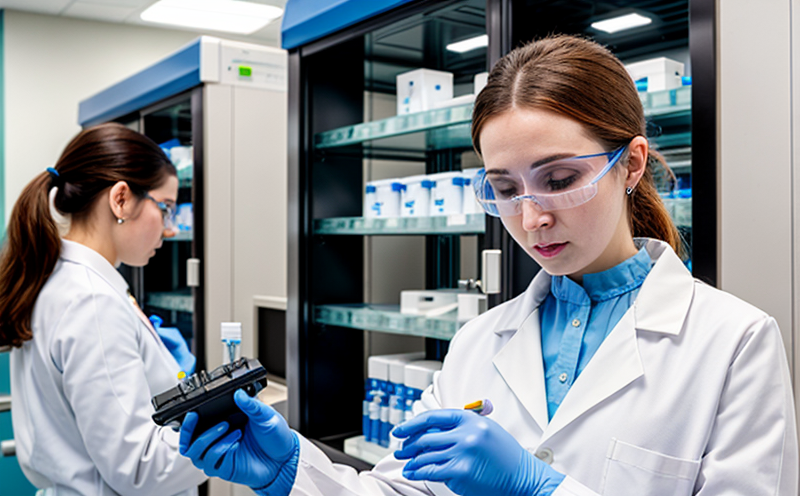ddPCR Digital PCR Bioanalysis Testing
The digital polymerase chain reaction (ddPCR) technology represents a significant advancement in quantitative and qualitative analysis of nucleic acids. This innovative approach allows for the precise quantification and localization of target DNA or RNA molecules within complex biological samples, offering unparalleled sensitivity and accuracy.
ddPCR is particularly advantageous when dealing with low-abundance targets, such as rare mutations or viral loads. It operates by partitioning a sample into thousands to millions of nanoliter-sized droplets in which the PCR reaction occurs. Each droplet contains either zero, one, or multiple copies of the target sequence. The distribution of these droplets provides a direct count of the target molecules without the need for a standard curve or external controls.
The ddPCR system is designed to ensure robust and reliable results through advanced optics and image analysis software. This technology can achieve an accuracy down to one part per million, making it indispensable in clinical diagnostics, drug development, and environmental monitoring. For instance, pharmaceutical companies often use this method during early-stage trials to detect potential impurities or contaminants in their product candidates.
Another critical application is in the field of personalized medicine where ddPCR helps tailor treatments based on individual genetic profiles. By identifying specific genetic markers associated with drug responses, clinicians can optimize therapy regimens for maximum efficacy and minimal side effects.
The instrumentation used in ddPCR testing includes specialized hardware that dispenses, amplifies, and detects DNA or RNA targets within the droplets. The process begins by preparing a sample containing the target nucleic acids along with probes specific to those sequences. These samples are then loaded into an array of microfluidic channels where they undergo emulsion-based partitioning.
The resulting droplet emulsions are subjected to PCR amplification under optimized conditions, ensuring efficient replication of the targeted regions. After amplification, the droplets are analyzed using fluorescence imaging techniques to determine whether each contains the desired sequence. This step involves capturing high-resolution images of individual droplets and processing them via sophisticated algorithms capable of distinguishing signal from noise.
The resulting data provides quantitative information about the presence and concentration of specific nucleic acids within the original sample. Importantly, this methodology eliminates variability introduced by traditional endpoint measurements or mass spectrometry approaches, providing more consistent results across different laboratories and platforms.
Compliance with relevant international standards such as ISO 17025 ensures that our ddPCR services meet stringent quality assurance requirements. Our team adheres strictly to these guidelines throughout the entire testing process, from sample preparation through final analysis and reporting.
Applied Standards
The digital PCR technology we employ complies with several key international standards including ISO 17025 for laboratory quality management systems. These standards ensure that our methods are validated rigorously against established criteria before being implemented in routine testing protocols.
- ISO 17025: This standard sets forth requirements for technical competence, quality assurance, and continuous improvement within laboratories providing services or results to demonstrate conformity with specified requirements.
Additionally, our procedures are validated according to ASTM E2389-16a, which specifies the procedure for absolute quantification using digital polymerase chain reaction. This standard provides detailed instructions on how to perform ddPCR experiments accurately and reproducibly while minimizing sources of error or bias.
To further enhance reliability, we also follow EN ISO 15189:2012, which focuses specifically on quality management in medical laboratories. Compliance with this standard guarantees that our testing practices align closely with best industry practices for accuracy, precision, and traceability of results.
Competitive Advantage and Market Impact
Our ddPCR bioanalysis service offers a competitive edge by providing highly sensitive and accurate quantification capabilities unmatched by conventional methods. This capability is especially valuable in areas like clinical trials where detecting minute variations can significantly impact therapeutic outcomes.
In terms of market impact, our expertise in ddPCR has enabled several breakthroughs in both academic research and industrial applications. For example, we have played a pivotal role in developing new assays for personalized medicine that are now being adopted globally. Our ability to provide precise quantitation data has also contributed substantially to accelerating drug discovery processes by identifying promising compounds early on.
Moreover, our commitment to adhering strictly to international standards has earned us a reputation as a reliable partner for pharmaceutical companies seeking to ensure regulatory compliance during various stages of product development. By leveraging our ddPCR technology, these organizations can confidently demonstrate the quality and safety profiles required by regulatory bodies worldwide.
Use Cases and Application Examples
- Clinical Diagnostics: Detecting rare mutations in cancer patients or identifying infectious diseases at extremely low viral loads.
- Drug Development: Monitoring drug metabolism in preclinical studies to optimize dosing regimens.
- Pediatric Medicine: Identifying genetic disorders early through non-invasive prenatal testing (NIPT).
- Environmental Monitoring: Quantifying microorganisms present in water supplies or soil samples.
In addition to these applications, ddPCR has been instrumental in forensic science by helping investigators analyze trace amounts of DNA left at crime scenes. This technology also plays a crucial role in agricultural biotechnology research by allowing scientists to study gene expression patterns within plants and animals.
Our team remains at the forefront of technological advancements, constantly exploring new ways to apply ddPCR beyond current limitations. With ongoing developments in probe design and reaction optimization, we anticipate even greater improvements in sensitivity and throughput over time.





